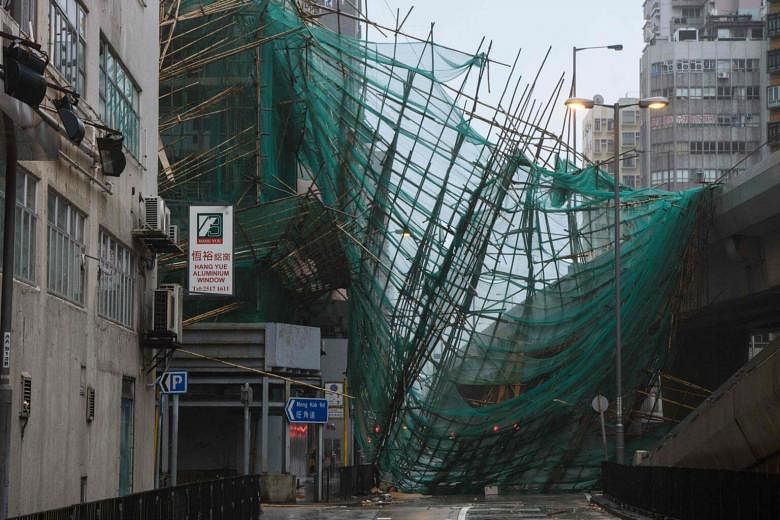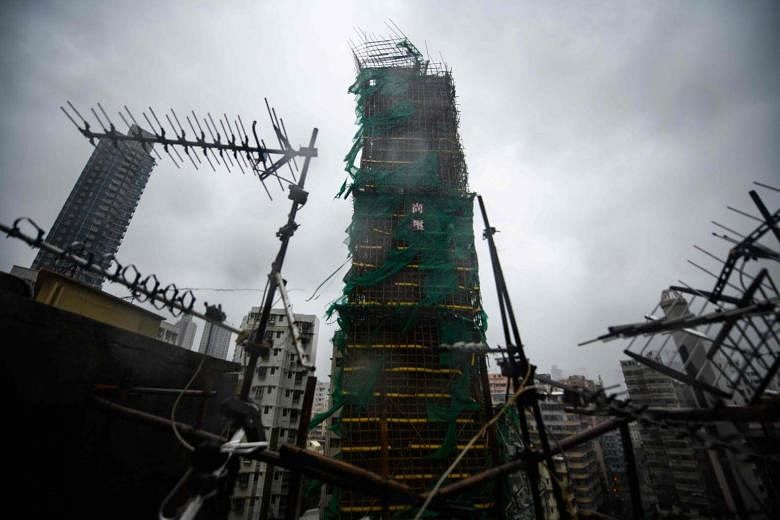HONG KONG (NYTIMES) - Typhoon Mangkhut continued its deadly path across Asia on Sunday (Sept 16), making landfall on the south-eastern coast of China and leaving at least two dead there, after battering Hong Kong and causing 11-foot storm surges in the city's harbour.
In southern China, the storm made landfall around 5pm near Jiangmen City, in Guangdong province, packing winds of 160kmh, the official news agency Xinhua reported.
State news media said that more than 100,000 people had been evacuated from the province, and the state broadcaster CCTV reported two deaths.
The typhoon was expected to weaken as it passed over mainland China, but it had already taken a considerable toll: Landslides in the Philippines buried dozens, including people sheltering in a church and a dormitory for miners, and the death toll there was expected to rise sharply as rescue workers began moving in.
Mr Francis Tolentino, a senior adviser to President Rodrigo Duterte, estimated that 5.7 million people had been affected by the storm, and that distributing rice and other supplies to the hardest-hit areas would be a major concern.
Xinhua, citing government reports, said that nearly 2.5 million people in Guangdong province had been affected in some way by the typhoon, with some seeking protection in more than 18,000 designated shelters.
Fishing boats had been ordered before the storm into anchorages, and authorities detained several fishermen who had defied the warnings.
Guangdong, China's most populous province, has extensive experience with typhoons, and makes elaborate preparations for each of them.
After 16 workers were killed when their shanty collapsed in a typhoon in 2003, the province pursued a strenuous campaign of demolishing or upgrading substandard housing.
The broader Pearl River Delta area, which also includes Hong Kong and Macau, is one of the world's most important manufacturing hubs and home to more than 60 million people.
For the first time ever, Macau, the Asian gambling capital nearby, closed its casinos because of a storm.
Roughly 20,000 households in the territory were left without power, the government said in a statement late on Sunday.
For Hong Kong, a city that can be blasé about tropical storms, Mangkhut was unlike previous typhoons.
It picked up speed as it crossed the South China Sea from its deadly march through the Philippines, landing a direct hit on Hong Kong at midday on Sunday and sweeping through the city's canyons of tall buildings.
By then, the city's normally teeming streets were clear of people and cars, as most residents heeded the local weather authority's signal 10 storm warning - its highest level.
But some tourists and local residents briefly ventured outside to marvel at the storm. "We came to look at the wind," a father said, after he and his son ran around the block.
Hong Kong Airport, a central transit point for much of Asia, was virtually shut down, with almost 1,000 flights cancelled or delayed.
The outdoor sections of the city's vaunted subway system were taken out of service, and high-speed rail in the neighboring province of Guangdong was also shut down.
The intensity of the storm in Hong Kong tested a city that has developed intricate safeguards against typhoons. The city's mountainous terrain typically hinders flooding, with retaining walls on steep slopes preventing deadly landslides.
But on Sunday, they were in danger of failing, leading the Hong Kong Observatory to issue a landslide warning, asking people to stay away from steep hills and retaining walls, and issuing evacuation notices to residents living in areas prone to landslides. Temporary shelters were opened.
Hong Kong residents had prepared for the storm by stocking up on groceries the night before, clearing shelves of many items and leading some merchants to raise the price of the tape people use on windows to contain damage.
On Sunday, most residents hunkered down in their apartments, while those in more flood-prone areas took refuge in shelters.
As the storm bore down, people took to Facebook and WhatsApp messaging groups, circulating pictures of the hurried preparations: cars and motorcycles mummified with cling wrap, indoor storefronts encased with spiderweb-like tape.
One Instagram user altered an image to add Spider-Man onto the side of a Hong Kong building, where he'd pitched in by putting tape on a window.
But as the storm unleashed its full force, the postings became more ominous. Videos showed glass windows and doors smashing, pedestrians being blown off the ground and residents frantically scooping rain out of their balconies to prevent flooding.
In the neighborhood of Mong Kok, video captured the collapse of a crane at a construction site, but no injuries were reported.
Fearsome winds caused storm surges as high as 3.35 metres in Victoria Harbour, which separates Hong Kong Island from the rest of the city.
The winds in Hong Kong started to die down in the afternoon as the typhoon headed toward the Pearl River estuary in Guangdong province, whose cluster of megacities are considered particularly prone to climate change. The province is home to more than 100 million people.
Ms Lily Chiu, a 60-year-old caregiver in Hong Kong, had stayed overnight at the nursing home where she worked to avoid commuting to an early shift when the storm hit.
Other than the tape on the windows of residents' rooms, it had been a normal day at work, with hot meals running on schedule, but something was different.
"These last few hours felt more severe than other typhoons I had experienced," she said, after speakers announced that train services to the station near her home had been suspended because of the storm. She prepared to walk home.
In the eastern Hong Kong neighbourhood of Heng Fa Chien, residents of a flooded housing complex linked arms and held hands as they waded knee-deep through pools of rainwater that doused the streets, parking lots and stores in low-lying area.
"How am I going to go home?" one elderly man asked despondently into a phone.
"Heng Fa Chuen has become a water reservoir," Ms May Siu, a long-time resident said. "I've lived here 30 years, and these storms only started looking like this with Hato last year," she said, referring to the biggest typhoon last year.
Shaking their heads at the snapped lampposts and flooded entryways, residents said that the storm on Sunday had done far more damage than last year's.
Then teenagers rolled up their shorts and prepared to wade home through floating debris.





